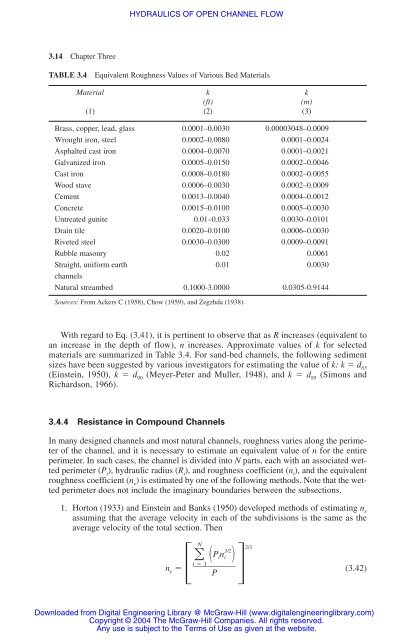chapter 3 hydraulics of open channel flow
chapter 3 hydraulics of open channel flow
chapter 3 hydraulics of open channel flow
You also want an ePaper? Increase the reach of your titles
YUMPU automatically turns print PDFs into web optimized ePapers that Google loves.
3.14 Chapter Three<br />
HYDRAULICS OF OPEN CHANNEL FLOW<br />
TABLE 3.4 Equivalent Roughness Values <strong>of</strong> Various Bed Materials<br />
Material k k<br />
(ft) (m)<br />
(1) (2) (3)<br />
Brass, copper, lead, glass 0.0001–0.0030 0.00003048–0.0009<br />
Wrought iron, steel 0.0002–0.0080 0.0001–0.0024<br />
Asphalted cast iron 0.0004–0.0070 0.0001–0.0021<br />
Galvanized iron 0.0005–0.0150 0.0002–0.0046<br />
Cast iron 0.0008–0.0180 0.0002–0.0055<br />
Wood stave 0.0006–0.0030 0.0002–0.0009<br />
Cement 0.0013–0.0040 0.0004–0.0012<br />
Concrete 0.0015–0.0100 0.0005–0.0030<br />
Untreated gunite 0.01–0.033 0.0030–0.0101<br />
Drain tile 0.0020–0.0100 0.0006–0.0030<br />
Riveted steel 0.0030–0.0300 0.0009–0.0091<br />
Rubble masonry 0.02 0.0061<br />
Straight, uniform earth 0.01 0.0030<br />
<strong>channel</strong>s<br />
Natural streambed 0.1000-3.0000 0.0305-0.9144<br />
Sources: From Ackers C (1958), Chow (1959), and Zegzhda (1938).<br />
With regard to Eq. (3.41), it is pertinent to observe that as R increases (equivalent to<br />
an increase in the depth <strong>of</strong> <strong>flow</strong>), n increases. Approximate values <strong>of</strong> k for selected<br />
materials are summarized in Table 3.4. For sand-bed <strong>channel</strong>s, the following sediment<br />
sizes have been suggested by various investigators for estimating the value <strong>of</strong> k: k � d 65<br />
(Einstein, 1950), k � d 90 (Meyer-Peter and Muller, 1948), and k � d 85 (Simons and<br />
Richardson, 1966).<br />
3.4.4 Resistance in Compound Channels<br />
In many designed <strong>channel</strong>s and most natural <strong>channel</strong>s, roughness varies along the perimeter<br />
<strong>of</strong> the <strong>channel</strong>, and it is necessary to estimate an equivalent value <strong>of</strong> n for the entire<br />
perimeter. In such cases, the <strong>channel</strong> is divided into N parts, each with an associated wetted<br />
perimeter (P i ), hydraulic radius (R i ), and roughness coefficient (n i ), and the equivalent<br />
roughness coefficient (n e ) is estimated by one <strong>of</strong> the following methods. Note that the wetted<br />
perimeter does not include the imaginary boundaries between the subsections.<br />
1. Horton (1933) and Einstein and Banks (1950) developed methods <strong>of</strong> estimating n e<br />
assuming that the average velocity in each <strong>of</strong> the subdivisions is the same as the<br />
average velocity <strong>of</strong> the total section. Then<br />
��<br />
N<br />
� i � 1<br />
ne �� P<br />
�P 3/2<br />
ini �<br />
�2/3<br />
(3.42)<br />
Downloaded from Digital Engineering Library @ McGraw-Hill (www.digitalengineeringlibrary.com)<br />
Copyright © 2004 The McGraw-Hill Companies. All rights reserved.<br />
Any use is subject to the Terms <strong>of</strong> Use as given at the website.

















